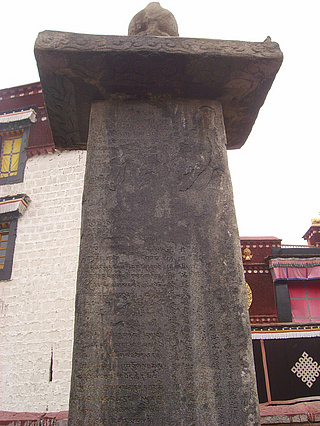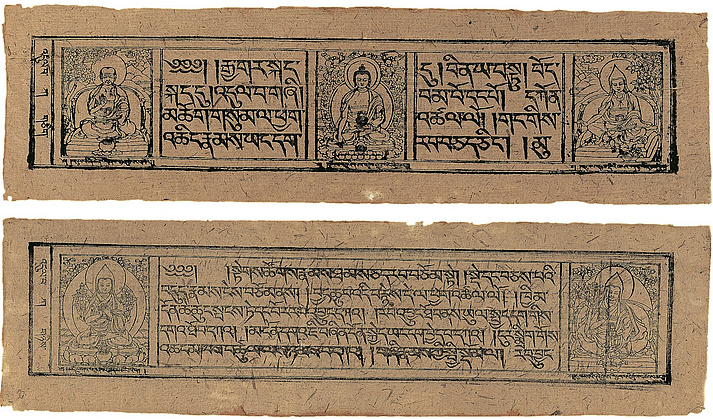Tibetan Language

According to Tibetan historiography, King Songtsen Gampo (Sroṅ-btsan sgam-po, reigned about 620–649 AD) sent his Minister Thönmi Sambhota (Thon-mi Sambho-ṭa) to India in order to create a script for the Tibetan language and to bring it back to Tibet. In fact, the Tibetan script is based on Indian archetypes and is, just like those, an alphabetic script. Moreover, Minister Thönmi is supposed to have authored the first grammar of the Tibetan language.
With the introduction of script, the first stage of the Tibetan language, Old Tibetan, becomes tangible. The oldest evidence of Tibetan language preserved today, the treaties between China and Tibet, can be found on stone steles from the 8th century. When the Tibetan Empire arose under Songtsen Gampo during the 7th century, Buddhism reached Tibet as well, bringing along numerous, primarily religious scriptures mostly translated by monks. Very soon, the Tibetan king regulated these translation activities. Binding rules were installed for how the works from Sanskrit, the classic Indian language, were to be translated to Tibetan.

These texts found their way into two large collections, constituting the Buddhist canon of Tibet: the “Translated Words”, the Kangyur (bKa’-’gyur), and the “Translated Treatises”, the Tengyur (bsTan-’gyur). As a translation language, the canonical Tibetan mirrors the cultural characteristics of Sanskrit in vocabulary and syntax, and it also had a lasting impact on the transition from Old Tibetan to Middle Tibetan.

The time period of Middle Tibetan lasted from the 11th to about the 18th century. Even during the 19th century there were still texts written that can be ascribed to this language stage, since the large part of Tibetan literature evolved during these centuries. The most creative period was between the 14th and 17th century, a historically formative time, when Buddhism finally established itself in Tibet and hundreds of monasteries were built. That was also the time of an important technical innovation for the dissemination of literature: texts were not any longer copied by hand but carved mirror-inverted into wooden blocks. The new woodblock printing technology allowed for producing and disseminating paper prints in any number.

Since the 18th century, starting in Central Tibet, Modern Tibetan developed into a common and administration language; today the Lhasa dialect is considered modern standard language. Besides, there are also many local dialects.
The Tibetan language is part of the Tibeto-Burman branch in the Sino-Tibetan language family. Thus, it differs fundamentally from the languages spoken in Europe with regard to grammar and morphology. An inflection of words as known in the Indo-European languages is hardly noticeable in Tibetan. Syntactical references are usually indicated by word order and function words, mainly suffixes or particles. Yet those can be frequently omitted and sentences therefore can often only be understood if a larger context is taken into account. For linguistic issues in general and for a vocabulary survey in particular, it is thus imperative not to record isolated phrases but to record text in larger contexts.
